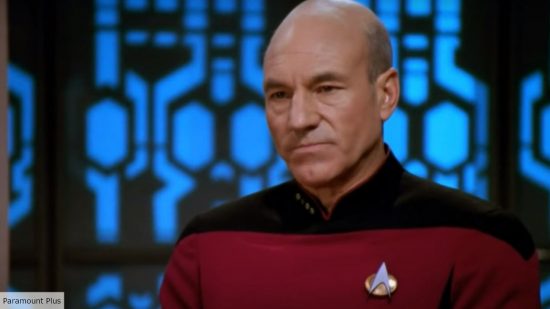While Star Trek TNG was on air between 1987 and 1993, efficiency was the word on everyone’s lips. Forget months and weeks: the cast and crew were shooting episodes in a matter of days to wrap on seasons that were up to 26 episodes long. The pressure was on.
There was an unwritten Star Trek rule then (enforced by franchise overseer Rick Berman) that camerawork, lighting, blocking, and other tools at a director’s disposal should be unshowy, both to give the Star Trek series that sense of consistency that we all know and love, and for the sake of simplicity. The focus, instead, would be on the story, the dialogue, and the Star Trek characters, leaving fancier filmmaking techniques to the movies.
Almost everyone obeyed these principles, apart from Jonathan Frakes. The Star Trek The Next Generation cast member, who’s still playing Riker 2023, insisted on flexing his directorial muscles whenever he took the helm behind the camera on an episode of the series (which he did, and still does, on numerous occasions). And, for the underrated classic ‘The Drumhead’ the actor truly had to pave his own way, and it paid dividends.
Speaking with Variety about the episode, which is nestled toward the end of season 4 and sees Picard’s loyalty to Starfleet under scrutiny, Frakes explained why he had to abandon the usual rules. “I tried to stretch the envelope,” the veteran explained, adding that doing so wasn’t easy because “Rick [Berman] was very strict. He was very traditional in his cutting.”

He continued, “I was very big on connecting questions to answers. I remember moving around the room and climbing up and down and staying with people, instead it being cut, cut, cut, cut. I love [it] when you connect what someone has said to the person who it said about or to.”
This wasn’t just Frakes showing off his talent, either. His direction of ‘The Drumhead’ elevates it from a by-the-numbers courtroom drama episode to something far, far more engaging and memorable – though still underrated.
Following on from a suggestion of conspiracy, Admiral Satie comes aboard the USS Enterprise-D to conduct an investigation into a suspicious explosion in engineering. What follows is a parable about the dangers of McCarthyism and paranoia, and the erosion of freedom and the presumption of innocence. There is no action, battles, or uniquely sci-fi premise: it’s all about the dialogue, and the interactions between characters.
It’s the kind of episode that demonstrates TNG’s flexibility and success in juggling genre and tone (it comes just one episode after the comedic romp ‘Qpid’), helping to cement it as one of the best TV series of all time. But, with its subtlety and dialogue-heavy approach to storytelling, ‘The Drumhead’ could have flopped if it had been directed by anyone less ambitious than Frakes.

His purposeful, swooping camera work — such as in this scene of Picard under questioning — hooks the audience in, and reveals the inner emotions of the characters. It tells us that Picard, for example, feels the pressure of many eyes, and illuminates Simon Tarses’ isolation. His direction is the perfect framing to allow the script and performances to shine.
Despite that, ‘The Drumhead’ still isn’t as highly regarded as it should be. It’s one of TNG’s very best, but you rarely see it alongside the likes of ‘The Inner Light’, ‘Tapestry’, ‘I, Borg’, or — even the most direct comparison — ‘The Measure of a Man’. It should rank in that upper echelon, and that’s all thanks to Frakes. It is one of Michael Dorn’s favorite episodes, at least.
Of course, ‘The Drumhead’ isn’t Frakes’ only directorial contribution to the best sci-fi series, and his defiant approach to directing is immediately noticeable with his first effort, ‘The Offspring’. Another classic, in which Data creates his own child called Lal, the titular android is distinctively introduced with a neat tracking shot, beautifully saturated lighting, and swelling music – not elements typically found in the TNG playbook.
All this success (he also directed the brilliant time-loop episode ‘Cause and Effect’ and the moral drama ‘The Quality of Life) meant that the actor followed in the footsteps of Leonard Nimoy, and also directed two Star Trek movies: First Contact and Insurrection. We’ll ignore Insurrection, but First Contact is a brilliant space thriller and the best movie in the TNG era.
Since then, he’s continued his hot streak with episodes of Discovery, Picard, and most recently Strange New Worlds. In fact, Frakes even directed the astonishing crossover with Lower Decks ‘Those Old Scientists’, and when we spoke with Anson Mount and Rebecca Romijn, Romijn explained, “having him on the crossover episode was imperative… He’s not afraid to admit when he’s wrong, which is great. It ends up being such a fun collaboration. It makes you brave to try lots of things. He encourages it.”
Full marks for Frakes then, across the board. What a legend.
For more on Frakes, see why he wants one episode of TNG banned, and how he wasn’t the first choice for Riker. Or, check out our complete guide to the Star Trek timeline before seeing all the latest updates on Strange New Worlds season 3 and Star Trek Legacy.
